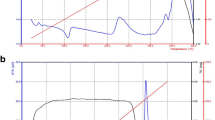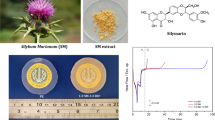Abstract
The purpose of this study was to investigate the utility of vacuum drying for removing peroxides from polyethylene glycols (PEGs). PEG solutions (PEG 1450 and PEG 20000) containing varying levels of peroxides were prepared by storing under different light and temperature conditions. PEGs containing low and high levels of peroxides were vacuum dried from dilute and concentrated solutions (2.5%, 7.5%, 15%, and 50% wt/vol of PEG 1450 and 2.5%, 7.5%, 15%, and 25% wt/vol of PEG 20000). Ferrous ion oxidation in presence of ferric ion indicator xylenol orange (FOX) colorimetric assay was used to determine the concentration of peroxides. Peroxide content in PEGs increased upon storage. The increase was more pronounced when PEGs were stored at higher temperatures and exposed to light. Vacuum drying at 0.1 mm Hg for 48 hours at 25°C resulted in greater than 90% decrease in the level of peroxides in all cases except when high peroxide containing 25% wt/vol solution of PEG 20000 or 50% wt/vol solution of PEG 1450 were dried. The reduction in the level of peroxides for PEGs dried from high peroxide containing 25% wt/vol solution of PEG 2000 and 50% wt/vol solution of PEG 1450 was found to be 88% and 52%, respectively. Oxidation of methionine in Met-Leu-Phe peptide was significantly reduced when vacuum-dried PEGs were used. Vacuum drying PEG solutions at low pressures is an effective method for the removal of the residual peroxides present in commercially available PEGs.
Similar content being viewed by others
References
Windholz M, Budavari S, Stroumtsos LY, Fertig MN. Polyethylene glycol (monographs).The Merck Index. Whitehouse Station, NJ: Merck and Co Inc; 1976:983–984.
Niazi S. Effect of polyethylene glycol 4000 on dissolution properties of sulfathiazole polymorphs.J Pharm Sci. 1976;65:302–308.
Dubois JL, Ford JL. Similarities in the release rates of different drugs from polyethylene glycol 6000 solid dispersions.J Pharm Pharmacol. 1985;37:494–495.
Francis GE, Fisher D, Delgado C, Malik F, Gardiner A, Neale D. PEGylation of cytokines and other therapeutic proteins and peptides: the importance of biological optimization of coupling techniques.Int J Hematol. 1998;68:1–18.
Gilliland GL, Davies DR. Protein crystallization: the growth of large scale single crystals.Methods Enzymol. 1984;104:370–380.
McPherson A. Use of polyethylene glycol in the crystallization of macromolecules.Methods Enzymol. 1985;114:120–124.
Mi Y, Wood G. The application and mechanisms of polyethylene glycol 8000 on stabilizing lactate dehydrogenase during lyophilization.PDA J Pharm Sci Technol. 2004;58:192–202.
Sharma VK, Kalonia DS. Polyethylene glycol-induced precipitation of interferon alpha-2a followed by vacuum drying: development of a novel process for obtaining a dry, stable powder.AAPS PharmSci. 2004;6:E4.
McGinity JW, Patel TR, Naqvi AH, Hill JA. Implications of peroxide formation in lotion and ointment dosage forms containing polyethylene glycols.Drug Dev Commun. 1976;2:505–519.
Hamburger R, Azaz E, Donbrow M. Autoxidation of polyoxyethylenic nonionic surfactants and of polyethylene glycols.Pharm Acta Helv. 1975;50:10–17.
McKenzie DA.A Study of Peroxide Formation and Decomposition in Certain Glycol Systems. Technical Service Reports. Tarrytown, NY: Union Carbide Corp; 1970.
Donbrow M, Azaz E, Pillersdorf A. Autoxidation of polysorbates.J Pharm Sci. 1978;67:1676–1681.
Ha E, Wang W, Wang YJ. Peroxide formation in polysorbate 80 and protein stability.J Pharm Sci. 2002;91:2252–2264.
Johnson DM, Taylor WF. Degradation of fenprostalene in polyethylene glycol 400 solution.J Pharm Sci. 1984;73:1414–1417.
Azaz E, Donbrow M, Hamburger R. Incompatibility of non-ionic surfactants with oxidizable drugs.Pharm J. 1975;211:15.
James KC, Leach RH. The stability of chloramphenicol in topical formulations.J Pharm Pharmacol. 1970;22:607–611.
Manning MC, Patel K, Borchardt RT. Stability of protein pharmaceuticals.Pharm Res. 1989;6:903–918.
Shechter Y, Burstein Y, Patchornik A. Selective oxidation of methionine residues of proteins.Biochemistry. 1975;14: 4497–4503.
Knepp VM, Whatley JL, Muchnik A, Calderwood TS. Identification of antioxidants for prevention of peroxide mediated oxidation of recombinant ciliary neurotropic factor and recombinant human nerve growth factor.J Pharm Sci Technol. 1996;50:163–171.
Mishima H, Terada G, Motoyama N, Kondo E, Suzuki K, Kimura K, inventors. Removal of peroxides. Japanese patent 50069011. June 9, 1975.
Ray WJ, Puvathingal JM. A simple procedure for removing contaminating aldehydes and peroxides from aqueous solutions of polyethylene glycols and of nonionic detergents that are based on the polyoxyethylene linkage.Anal Biochem. 1985;146: 307–312.
Segal R, Azaz E, Donbrow M. Peroxide removal from nonionic surfactants.J Pharm Pharmacol. 1979;31:39–40.
Jaeger J, Sorensen K, Wolff SP. Peroxide accumulation in detergents.J Biochem Biophys Methods. 1994;29:77–81.
Author information
Authors and Affiliations
Corresponding author
Additional information
Published: July 28, 2006
Rights and permissions
About this article
Cite this article
Kumar, V., Kalonia, D.S. Removal of peroxides in polyethylene glycols by vacuum drying: Implications in the stability of biotech and pharmaceutical formulations. AAPS PharmSciTech 7, 62 (2006). https://doi.org/10.1208/pt070362
Received:
Accepted:
Published:
DOI: https://doi.org/10.1208/pt070362




